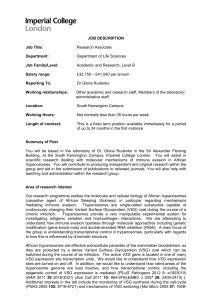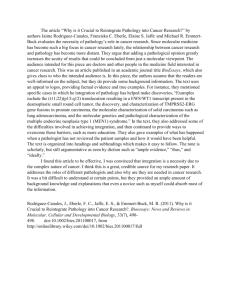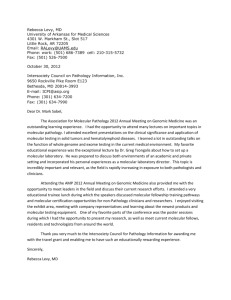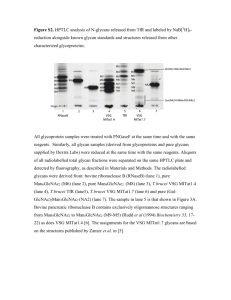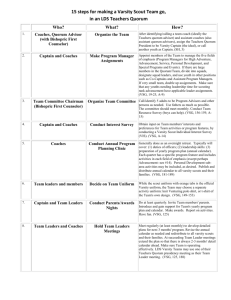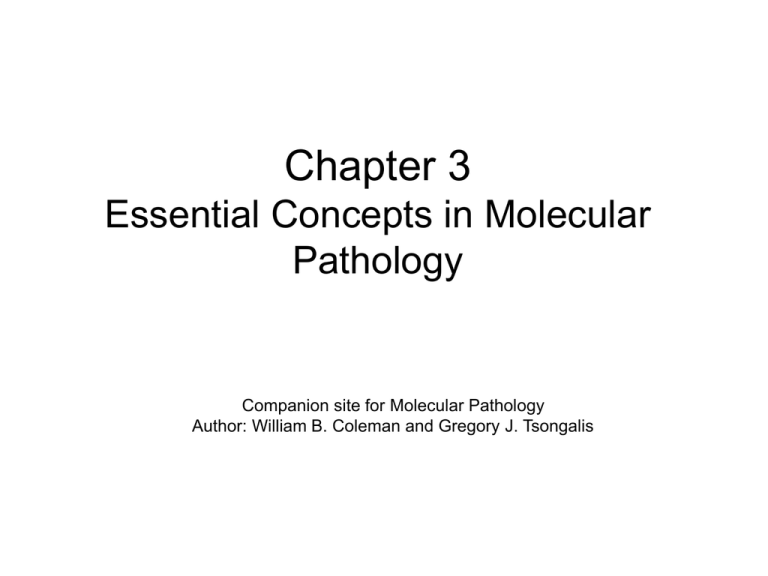
Chapter 3
Essential Concepts in Molecular
Pathology
Companion site for Molecular Pathology
Author: William B. Coleman and Gregory J. Tsongalis
FIGURE 3.1
Mechanisms of generating antibody diversity. C regions and sequences are in shades of purple; J regions and
sequences are in shades of green, and V regions and sequences are in shades of red. Altered or mutated sequences
are in yellow. Designations of sequences (V1, etc.) are arbitrary and not meant to represent the actual arrangement of
specific elements. (A) The inherent germline diversity of V and J regions provides some recognition diversity. (B) The
combinations of V and J regions (V, D, and J in heavy-chains) provide additional diversity. (C) The V-J junctions
undergo semirandom alterations during recombination, generating more variants. (D) In activated B-cells, the variable
regions are hypermutated. (E) V regions of both light and heavy chains combine to form the antigen-recognition zone of
the antibody. They can combine in different ways to provide still more variety of antigen recognition.
Companion site for Molecular Pathology
Copyright © 2009 by Academic Press. All rights reserved.
2
FIGURE 3.2A
Mechanisms for generating variant surface glycoprotein diversity in trypanosomes: VSG
genome structure. VSG sequences are in shades of red, others are purple. Silent VSG genes are
dark red; expressed VSG genes are bright red, and VSG pseudogenes are pink. The large dots at
the end of the chromosome represent telomeres. Green arrows are VSG promoters. ESAG are
Expression Site Associated Genes, non-VSG genes, which are part of the polycistronic transcript
driven by the VSG promoter. Designations of sequences (VSG1, etc.) are arbitrary and not meant to
represent the actual arrangement of specific elements.
Companion site for Molecular Pathology
Copyright © 2009 by Academic Press. All rights reserved.
3
FIGURE 3.2B
Mechanisms for generating variant surface glycoprotein diversity in trypanosomes: Expressing new
VSG. VSG sequences are in shades of red, others are purple. Silent VSG genes are dark red; expressed VSG
genes are bright red, and VSG pseudogenes are pink. The large dots at the end of the chromosome represent
telomeres. Green arrows are VSG promoters. The Xs represent recombination or gene conversion events.
ESAG are Expression Site Associated Genes, non-VSG genes, which are part of the polycistronic transcript
driven by the VSG promoter. Designations of sequences (VSG1, etc.) are arbitrary and not meant to represent
the actual arrangement of specific elements. a. Post-transcriptional regulation causes different VSGs, located
in alternative telomeric ESs, to be expressed. b. Recombination can switch a VSG gene from a
minichromosome or other telomere to an ES. c. Gene conversion events can alter the sequence of VSGs
located at ESs or elsewhere, drawing upon the sequence diversity not only of the silent VSGs but also of the
VSG pseudogene pool.
Companion site for Molecular Pathology
Copyright © 2009 by Academic Press. All rights reserved.
4
FIGURE 3.3
Chemokines secreted by macrophages in response to bacterial challenge.
Chemokines secreted by macrophages have both local and systemic effects,
which mobilize defenses to infection, but may have unfortunate consequences as
well.
Companion site for Molecular Pathology
Copyright © 2009 by Academic Press. All rights reserved.
5
FIGURE 3.4
Mechanisms by which Stapylococcus aureus evades opsonophagocytosis. The figure illustrates (a) the
capsular polysaccharide, which can compromise neutrophil access to bound complement and antibody; (b) the
extracellular staphylokinase (Sak), which activates cell-bound plasminogen and cleaves IgG and C3b; (c) protein
A with 5 immunoglobulin G (IgG) Fc-binding domains; (d) fibrinogen-binding protein (EfB), which binds
complement factor C3 and blocks its deposition on the bacterial cell surface. Complement activation beyond C3b
attachment is prevented, thereby inhibiting opsonization. (e) Clumping factor A (ClfA), which binds the γ-chain of
fibrinogen. Reprinted with permission from Nature Publishing Group, Nature Reviews Microbiology, 2005;3:952.
Companion site for Molecular Pathology
Copyright © 2009 by Academic Press. All rights reserved.
6
FIGURE 3.5
Mycobacterium tuberculosis and the macrophage. Gray arrows are host
endosome processing pathways; the pink lines are mycobacterial mechanisms.
Fusion of mycobacteria into mature phagolysosomes usually leads to death of the
organism, so mycobacteria select their endocytotic pathway and interfere with
mechanisms designed to result in phagosome-lysosome fusion. PI3K =
phosphatidylinositol-3-kinase; PI3P = phosphatidylinositol-3-phosphate; LAM =
lipoarabinomannan.
Companion site for Molecular Pathology
Copyright © 2009 by Academic Press. All rights reserved.
7
FIGURE 3.6
A mycobacterial granuloma. H&E stained sections of a mycobacterial
granuloma. Central necrosis and an inflammatory response consisting of
macrophages, lymphocytes, and fibroblasts are apparent. A large
multinucleated giant cell, characteristic of the granulomatous reaction, is
also present.
Companion site for Molecular Pathology
Copyright © 2009 by Academic Press. All rights reserved.
8
FIGURE 3.7
The structure of the HIV virion. Schematic illustration of an HIV virion.
The viral particle is covered by a lipid bilayer that is derived from the host
cell. Reprinted with permission from Elsevier Saunders. Robbins and
Cotran: Pathologic Basis of Disease, 7th edition, copyright 2004, page
247.
Companion site for Molecular Pathology
Copyright © 2009 by Academic Press. All rights reserved.
9
FIGURE 3.8
Pathogenesis of HIV-1 infection. Pathogenesis of HIV-1 infection. Initially, HIV-1 infects T-cells and
macrophages directly or is carried to these cells by Langerhans cells. Viral replication in the regional lymph
nodes leads to viremia and widespread seeding of lymphoid tissue. The viremia is controlled by the host immune
response, and the patient then enters a phase of clinical latency. During this phase, viral replication in both Tcells and macrophages continues unabated, but there is some immune containment of virus. Ultimately, CD4+
cell numbers decline due to productive infection and other mechanisms, and the patient develops clinical
symptoms of full-blown AIDS. Reprinted with permission from Elsevier Saunders. Robbins and Cotran:
Pathologic Basis of Disease, 7th edition, copyright 2004, page 248.
Companion site for Molecular Pathology
Copyright © 2009 by Academic Press. All rights reserved.
10
FIGURE 3.9
Opportunistic pathogen in AIDS. Cluster of Pneumocystis jirovecii cysts
stained with toluidine blue in bronchoalveolar lavage of an HIV-positive
patient (oil immersion, magnification 1000x).
Companion site for Molecular Pathology
Copyright © 2009 by Academic Press. All rights reserved.
11

